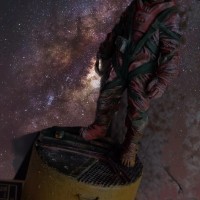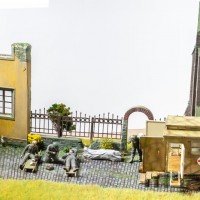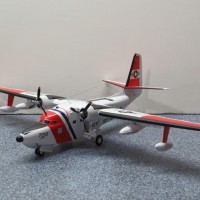When boats fall from the sky: the B-17H/ SB-17G and the A1 Higgins rescue boat
When the crew of a B-17 “Flying Fortress” prepared for the final approach and the bombardier climbed forward to the glazed nose cockpit to bend over the bomb sight in concentration, the people on the ground below had to fear death and destruction. But not with this particular B-17! Here, the sight of the approaching “Flying Fortress” meant the prospect of rescue for those on the ground: what this aircraft would drop was a remarkably equipped, ocean-going lifeboat that, in addition to immediate protection, medical care, water and food, enabled the distressed ship's crews and pilots in distress to make the rescue journey to the coast or ships.
The following article should therefore also begin with some information about the actual protagonist of the SB-17H missions, the 10-meter-long “Higgins” lifeboat mounted under the hull!
The A1 Higgins lifeboat
The idea for the spectacular rescue by jettisoned boat was born in 1943. Crews in distress had already been rescued from the sea by being picked up by seaplanes, but that year the British were the first to parachute a 10-metre lifeboat specially designed for airdropping onto the water. US boatbuilding legend Andrew Higgins, already a manufacturer of high-quality and technically refined boats in pre-war times and later an important manufacturer of a large number of amphibious landing and PT boats during the war, decided shortly afterwards to design an improved and, above all, more resistant drop-capable boat for these “Dumbo” missions. He revised the British design, which incidentally also came from a well-known sailor, Uffa Fox, with the aim of creating a much more stable and efficient lifeboat.
Performance, equipment and launching of the lifeboat
The result was the “A1 Higgins Lifeboat”, a lifeboat weighing 1,500 kilograms and 8 meters long, powered by two air-cooled engines. It was made of laminated mahogany and the hull was divided into 20 closed, air-filled compartments, which should theoretically make the boat unsinkable. Another key improvement was its ability to self-right, so that even if it capsized or was pushed completely under water, it remained buoyant and drivable.
The approaching B-17H had to release the boat at a speed of 190 km/h and at an altitude of 500 meters as soon as it flew over the people to be rescued. After a short free fall, three USAAF-standard 15-meter parachutes were pulled out of their envelopes by rice lines connected to the aircraft. Hanging from these parachutes, the bow of the boat tilted downwards by 50 degrees and then hit the water at a sinking speed of around 30 km/h. Immediately afterwards, several lifelines were automatically shot 360 degrees around the boat about 200 meters into the water using rocket propellants; this was intended to make it easier for the casualties to get on board.
The equipment of the A1 Higgins lifeboat was impressively well thought out and based on previous experience: there was space on board for up to 12 people, who were provided with emergency medical equipment, dry clothing, maps with an indication of the approximate position, as well as water and provisions for around 20 days. To propel the boat, in addition to the two engines, a simple sail was also prepared, which was designed so that it could also be handled by untrained sailors. Interestingly, the meter-long antenna of a Gibson Girl survival radio was held in the air with a kite. The effective range of the A1 boat was around 2500 kilometers. The two built-in engines propelled the Higgins boat to around 8 km/h via the propellers located under the hull, which could mean a daily distance of around 160 to 240 kilometers to the rescuing shore.
A dramatic first mission
The very first mission of the Higgins lifeboat on March 31, 1945 illustrates well how complex such a rescue could be: the day before, the pilot of a P-51 Mustang had ditched off the Dutch coast near Schiermonnikoog. After the PBY Catalina, which had been used in an initial rescue attempt, was itself damaged during the ditching, the Mustang pilot had to be abandoned - but he drifted to the coast on his dinghy and was captured there by the Germans. The damaged Catalina could no longer take off under its own power and its six crew members were now in distress themselves. A Fox lifeboat dropped from a Vickers Warwick broke up in the rough sea and damaged the flying boat, which began to sink. The crew took to their inflatable boats, which would not have helped them for long in the approaching storm. Another Fox lifeboat launch also failed, so that the dicey situation now threatened to become dramatic. It proved to be very fortunate that a B-17H with the new lifeboat was in the vicinity and was actually able to drop it with pinpoint accuracy. This time the Catalina crew managed to drop the boat and get on board. The following events show just how lucky they were to be in one of the new lifeboats: for the next three days, the six men in the A1 lifeboat weathered one of the strongest storms recorded in the area in recent years. It was not until April 4 that they were picked up by two rescue motor launches in the still rough seas. The life-saving Higgins boat was sunk by gunfire as it could no longer be towed.
However, the most common area of operation for the B-17H and its A1 boats was not to be Europe, but the Pacific in the last eight months of the war. Here, the rescue Flying Fortresses were positioned along the flight paths of the B-29 bombers, which bombed distant targets in Japan from their bases on Guam, Saipan or the Mariana Islands. The “Dumbo missions” of the B-17H with their A1 lifeboats saved the lives of countless crews in distress who would otherwise have been lost in the terrifying expanses of the Pacific until the end of the war.
The sea rescue variant of the B-17 remained in service after the war. The armament and armor were dismantled and were not to be taken back on board until 1950, when the SB-17s were again to be used to rescue downed B-29 Super Fortresses, this time attacking North Korean targets.
About the kit and the building process
I am now familiar with the Academy kit, the first edition of which dates back to 1988, from several projects - and I have come to appreciate it more and more. For me, its qualities lie on the one hand in its very reasonable accuracy of fit, and on the other in the fact that it is neither overloaded nor overcomplicated. The fact that this is reflected in a moderate price is certainly another advantage.
As a result of the above, it is necessary to add details where they seem important to you personally. In my case, this was the cockpit/nose area, the engines and the chassis area. There is a wide range of help available here, etched parts from Eduard were used. The representation of the tires also gains significantly by replacing them with resin parts.
However, I have noticed one annoying peculiarity in all projects with this kit: the V-position of the wings seems too steep to me. I reacted to this by simply mounting the wings a little flatter; I am happy to accept the two gaps this creates for a more harmonious look!
The yellow areas on the fuselage and wings were masked off and painted, as were their black markings. All other markings were realized with the kit decals, which, despite their age, were quite pleasant and easy to work with. The areas in NMF were painted with Alclad II/ Ammo MiG aluminum paints, which were applied in several coats.
Conclusion
I found the exploration of the theme of the “Dumbo” missions, the story(s) surrounding the Higgins boats and a B-17 variant that saves lives, very enriching and interesting. I therefore suspect that this will not be my last model of this iconic aircraft type, which can tell unexpectedly many different stories!


























A very informative article, superb modelling skills, and an impressive set of photographs. Well done!
Thank you for these appreciated words!
What Robert said, Roland!
Congratulations!
Thank you Spiros!
A great article and ditto build, Roland @rosachsenhofer
Never saw this variant before.
Thanks for sharing this interesting topic.
Your words and your interest make me happy - thank you for your feedback!
483575...what a gorgeous build...the serial number is pretty poignant to myself and I'm sure a lot of others. I've got over 900 hours in her and was type rated back in 2009. She was built in Long Beach and delivered to the USAAF in early 1945. She would eventually see her way on to the civilian market as Fire Bomber and then a flying museum/ride airplane "909". She was pressed in to service as you have wonderfully depicted her as an Air Rescue platform. After her time with Air Rescue she was flown to Yucca Flats Nevada in 1952. She was used as a ground based Nuclear Test airframe and saw as many as 3 blasts. In 1965 she was sold to Valley Scrap metal and then on to Aircraft Specialties of Mesa AZ. She was rebuilt at the Nuclear test site and flown out after an extensive rebuild on May 14, 1965. She was used as a "spares" airframe until the decision was made to do a full tanker conversion in 1977. She flew as Tanker 99 for Globe Air until 1985 when she was aquired at auction by the Collings Foundation. She was rebuilt to WWII condition and began flying airshows around the Northeastern United States. The Foundation had also aquired a B-24 project from India via Doug Arnold and was put in the restoration que. Once it was completed, during 1989, the 2 bombers embarked on a 6 year 50th Anniversary Tour around the U.S. teaching WWII history. During the final planned season of 1995 the tour was winding down...there was an overwhelming outcry from the public to keep them flying. Based on this enthusiasm a new business model was created to keep them going by offering rides. For over 30 years the tour, on average, would visit 110 cities in 38 states per year. 575 gave thousands of people a chance to both see the inside of a B-17 and/or take a ride. Unfortunately, in 2019, she was lost to a tragic and avoidable accident...but thats a different can of worms. She gave a lot of people a new perspective on the air war, and she gave many a veteran "one more mission". As a side note, the left horizontal data plate was marked B-17H...given the way modern warbirds can be a hodge podge of parts, I always thought that was a neat reminder of this service. You've built a beaut and brought back a lot of great memories.
Jim
7 attached images. Click to enlarge.
I was really impressed by your answer, you can feel the enthusiasm and the deep involvement, which really gives me goose bumps. It's doubly nice to hear all this: I've really wanted to build the kit for this machine for a long time - and I had no idea what a breathtaking history this machine had accumulated! Thank you for the wealth of information and the pictures - great!
You bet! I may have to hunt this kit down and do one for my shelf. One other point of interest, along both sides of the nose, back to the bombay were the boat mounting points. They were never removed during restoration. I wish I would have documented that better, but all that was left in place. Again, great build!
Jim
"9-0-9" did her job of education. In 1996, my new girlfriend and future partner went with me over to Van Nuys airport to see her and the B-24, then as "All American." She met a couple old B-17 crewmen while waiting for the arrival, and heard their stories of their time in B-17s. They then gave her a guided tour of "9-0-9". She climbed out, turned and looked at the airplane, and said "I'll never look at one of these old airplanes the way I used to."
Some other photos of her over Los Angeles in 1998. (the second one is over Aaron Spelling's enormous 50,000 sq ft plus Beverly Hills mansion/castle)
4 attached images. Click to enlarge.
Tom, thank you very much for this personal and associative story - and I am impressed by the stories this B-17 was able to tell!
Beautiful model and great piece of history!
Excellent build and very interesting history of the Higgins life boat.
So much interesting about the history of this plane. Love the Higgins boat concept and explanation. Wonderful build. Thanks much for sharing.
Nicely done Roland, a little different.